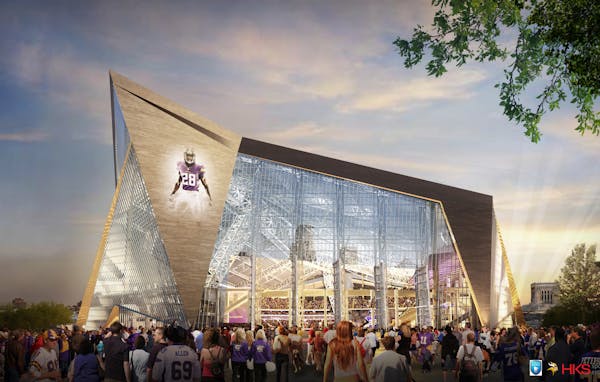Tailgaters, take heart: The Minnesota Vikings have your back.
With concerns growing over a rapidly dwindling supply of prime tailgating spots around their new downtown Minneapolis stadium for the 10,000 or so gameday tailgaters, the team has asked city officials to consider expanding the area for pre- and postgame festivities.
The request, made at a meeting Thursday of the city's Stadium Implementation Committee, comes in response to feedback from some disgruntled season-ticket holders over a $400 million office, retail and housing development near the stadium that will gobble up more than 800 premium tailgating spaces.
"It's a hot-button issue with our fans," said Lester Bagley, the Vikings vice president of public affairs and stadium development.
Vikings officials surveyed nearly 22,000 single-game or season-ticket holders on the issue this spring. Nearly two-thirds of the roughly 3,000 fans who responded said it was "very important" to be able to pull out the coolers and the grills and continue the tailgating tradition at the new stadium.
More than half, however, said they wanted to be within walking distance of the stadium and preferred not to park and tailgate at lots farther away or use a shuttle service to get to and from the game.
Nearly three out of four ticket holders who responded said they would share or consider sharing tailgating space at a nearby park or plaza.
Based on the survey, the Vikings estimate that about 840 fans host weekly tailgating parties, with an average of 10 guests per vehicle or space. The total number of tailgaters may, however, be closer to 10,000, team officials said.
For many, Bagley said, "it's about being in the vicinity of the stadium, to put down their beverage and walk to the game so they can pull into their seat when the game is about to tee off."
Groundbreaking on the stadium, to be built on the Metrodome site, is scheduled for later this fall.
The team expects the building to be open in time for the 2016 NFL season.
Stadium construction will coincide with an ambitious plan by Ryan Cos. to redevelop five nearby blocks now owned by the Star Tribune for the office, retail and housing project, as well as a 9-acre public park.
Three of the blocks currently are prime tailgating lots, providing more than 800 parking spaces.
"The Ryan project is a huge benefit to the city, but it also puts some pressure on the tailgating experience," Bagley said.
Chuck Lutz, Minneapolis' deputy development director, said Thursday that he and Mayor R.T. Rybak met with the Vikings earlier this month to discuss ways to compensate for the loss of the tailgating spots and preserve the pre- and postgame tradition.
A second meeting is planned for next week.
Lutz said the city and the Vikings will explore the possibility of using other surface parking lots close to the Metrodome for tailgating. The team is looking to double the size of the current tailgating area, possibly extending it south to S. 10th Street and east to Interstate 35W.
"We're committed to working cooperatively to find some solutions," he said.
Other options discussed at Thursday's committee meeting included blocking off some downtown streets on gamedays to allow for tailgating and building a massive deck over I-35W to connect the stadium site to the Cedar-Riverside neighborhood, where more parking could be made available.
David Fields, development director for the nearby Elliot Park neighborhood, said he was receptive to the idea of finding parking solutions to the neighborhoods east and to the south of the stadium — where Elliot Park is located.
"We are not, at Elliot Park, at all against tailgating," he said.
But he added that it could be difficult to find a permanent solution given the ever-changing landscape of the city and fluid nature of development.
"This is just a meantime solution," Fields said. "Because ultimately, we will always be arguing for the development and redevelopment of these surface parking lots."
Railgating, too
The Vikings tailgating tradition took a big hit in the early 1980s after the team moved from Metropolitan Stadium in Bloomington, which offered thousands of surface parking spaces, to downtown Minneapolis.
Last fall, in an effort to "add more sizzle" to the gameday experience, and anticipating that some lots surrounding the Metrodome could eventually be lost to post-stadium spinoff development, Rybak and city officials unveiled the concept of "railgating."
The idea, an alternative to traditional tailgating, was launched as an experiment of sorts to get fans to head downtown and participate in pregame festivities.
For several Sundays last fall, food and beverage trucks set up along light-rail lines in a three-block stretch of 5th Street leading from the Metrodome to downtown to give fans more food options.
Nearly 1 in 5 fans attending Vikings home games travels to the stadium, located in one of the NFL's most urban settings, by light rail.
That number is projected to jump to 1 in 4 when the stadium opens in 2016.
Lutz said the city plans to tweak the concept for this coming season, the team's final season in the Metrodome.
"The situation is evolving," Bagley said of tailgating options, "and we need to provide options and alternatives."
Richard Meryhew • 612-673-4425

Want to share info with the Star Tribune? How to do it securely

'Safe recovery sites' would offer syringes, naloxone and more to people using drugs. The plan could be in peril.
New Minnesota GOP leaders seek peace with party's anti-establishment wing

Who is Republican Lisa Demuth, Minnesota's first House speaker of color?

